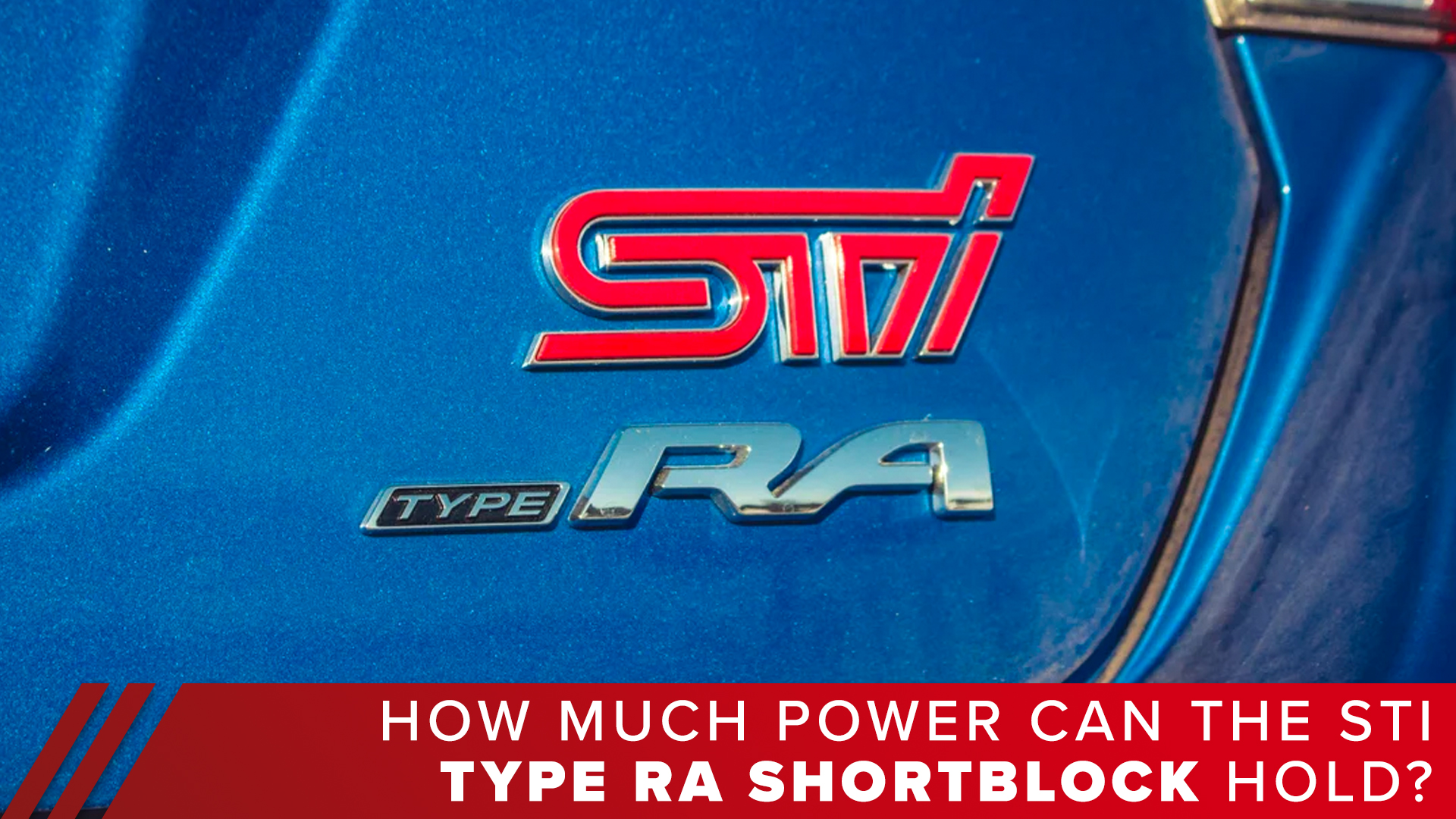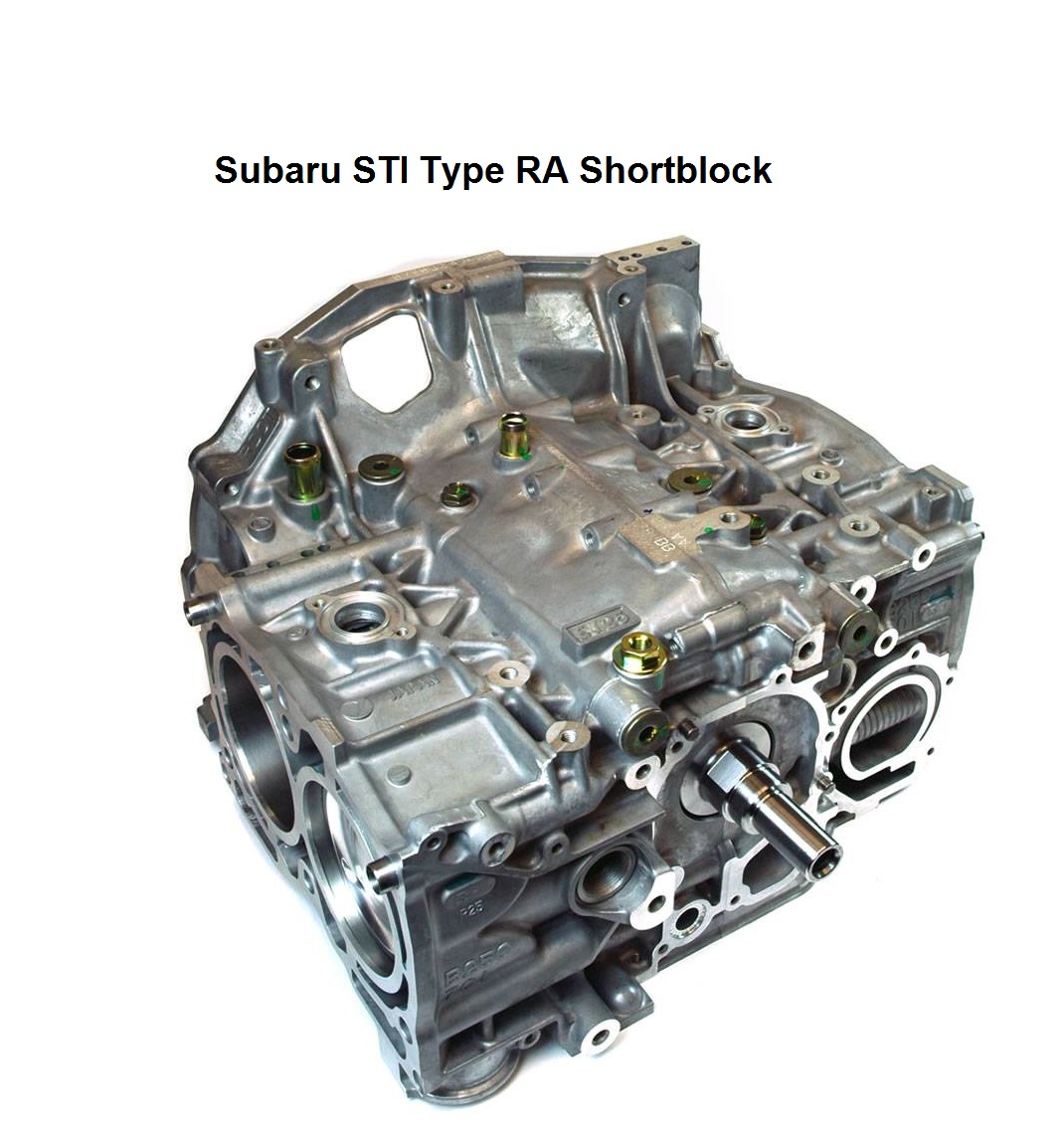We use cookies to make your experience better. To comply with the new e-Privacy directive, we need to ask for your consent to set the cookies. Learn more.
How much power can the STI Type RA Shortblock hold?

From the time the STI debuted here in the US with a 2.5 liter engine, it did not take long for tuner’s and enthusiasts to discover that the EJ257 engine could make some good power with simple bolt-ons. They also discovered that you had to address some weaknesses if you wanted to push the power of the engine past the 350 wheel hp to 400 wheel hp range. The first weak link that was discovered was the stock cast pistons, then the rods, and so on. At this point, there are great aftermarket options for every single component of the stock engine, including the case itself (with sleeves and closed deck inserts, etc.)
As many good options and up-grade paths as there are, there has also always been the dream that the STI would get an engine that was a bit more stout. An engine that could make and hold a bit more power so that the threshold where you had to spend the money to replace the stock engine with a fully built engine with after market pistons and rods, etc., would be higher.
Then in 2018, the limited production STI Type RA came out, and it was rated to make a whopping 5 more hp than the standard STI at 310 hp. Then some of the information came out from Subaru about what was done to get this gain, and one of the things mentioned was that Subaru built the STI Type RA engine with reinforced pistons. As soon as the parts schematics landed in the Subaru catalog, people discovered that the Type RA STI had not only a different shortblock part number from the standard STI, but pretty much every part number for the engine was different.
This in and of itself is not that unusual for a special edition of the STI. But knowing that Subaru said that the engine and specifically the pistons had been improved, everyone was really curious to know how much better the engine really was. At first, because the STI Type RA was fairly limited in production there weren’t many parts available, but eventually, a couple of shortblocks ended up in the Subaru warehouse, and were ordered up by people and shops that wanted to either try them out, or to take a look at what Subaru had done differently.
Then the 2019 STI came out, and it turned out that the from that point on, all STI’s got this new Type RA block (Subaru part number 10103AD020). This meant that the Type RA block was a lot more available, and every STI from that point was a potential test bed to see what this new block had to offer in terms of performance and reliability.
In short, the burning question is, how much power can an STI Type RA block hold?
There are a lot of rumors out there, and it seems that the more time goes on, the more you see or hear mention of a Type RA block that is holding a lot more power than you would think possible. In some circles of the internet, there are even discussions that the STI Type RA block is a worthy replacement for a Stage 1 built block with forged pistons, but at a big cost savings.
But is it really? Is an STI Type RA block really just as capable of holding the same power as a Stage 1 block?
Well, my first question is, what do you mean by “hold”?
Let’s say you have a race car, and you have a Type RA block installed. You are on the dyno, and do a pull and hit 400 whp. Then your tuner makes some adjustments, and does another pull, and you hit 420 whp on your RA block. The car is still running, and there are no signs of trouble.
So does this mean that the RA block can hold 420 whp? It is a good start, but no, that is not exactly what this means.
Let’s push the example a bit further. Say you have the same scenario, but the car puts down 500 whp, and then 550 whp. Then you decide to do one more pull without making any changes just to verify the number and the engine fails.
Does that mean that an RA block can hold 550 whp?
What if the car reliably made that power on the dyno, but in your first 20 minute session on track, the engine let go? Would that be enough to say that the RA block can hold 550 whp?
I think it is reasonable to say that most people that either have an STI with a Type RA block from the factory, or that have installed a Type RA block into their car do not plan on removing and tearing it down every 10 hours of use, or 1,000 miles, which ever comes first. That is not something that they would consider a reasonable service interval. Heck, 10 times that still wouldn’t be considered an acceptable service interval for the engine. The expectation would be that the engine would last at least say 5 years or 50,000 miles, and for some of us, even that wouldn’t be enough.
The point here is that when most people want to build their car to make power, the goal is that the car can be driven however you want to drive it, and that it will make that power reliably, with minimal issues, for a long time. This is most likely what most of us think when we say that an engine can “hold” a given amount of power.
So for a new platform like the RA block, if there is a new threshold where the engine can make more power than the previous EJ257 reliably, there needs to be a good number of cars that are making that power for a good while. Most likely for more than a year, and for well over 10,000 miles at a start before that new threshold could be considered valid.
Before the STI Type RA block came out, we told customers that the safe power threshold for a stock EJ257 was right about 350 whp. If you put on a turbo with supporting mods and had a good tune (and a the importance of a good tune cannot be overstated), then you can make that power reliably. And with any built block, we say that the average expected life of the block is between 60,000 and 80,000 miles (and that average live goes down as the power target goes up).
Our stance has always been that if you want to get 100,000 miles or potentially more out of your engine, the best way to do that is to stay with a stock shortblock, and keep your power goal reasonable. Conversely, if you want to make more than 350 whp, your best bet at getting to that 60k to 80k mileage mark is to go with a built block with components that will support your end power goal, and a really good tune.
And even now that the Type RA block is available, that is still what we say and recommend.
Because the Type RA block is so close in price to the standard EJ257 block, for many applications, we recommend going with the RA block because in the long term there may be some benefits from those new parts that Subaru put in. But it is just too soon to know if you can safely and reliably push the limits further.
But yes, we are starting to do some testing of our own. If you have been following the build of our Pikes Peak race car, that is the example that I started out with. We are currently making 420 whp on E85 and that engine had done a couple of track days and 2 years running up Pikes Peak, so we are starting collect some data and miles on this new engine. Hopefully if we can keep everything together for a good deal more track days and races, we’ll have a better picture of what the Type RA block can handle.
- Jon Cooley


